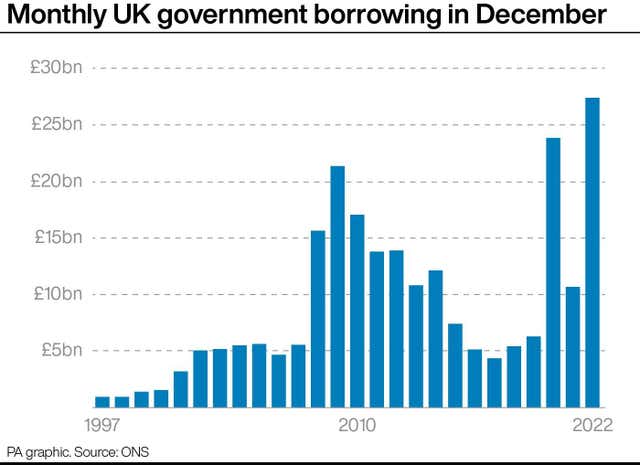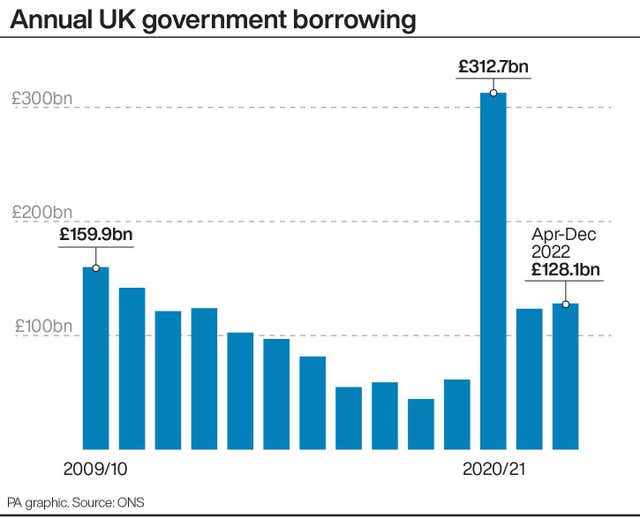
Tonight with Andrew Marr 6pm - 7pm
24 January 2023, 10:14

The Office for National Statistics said government borrowing hit £27.4 billion last month.
The mounting cost of the Government’s energy support schemes and soaring debt interest pushed state borrowing to another record last month as sky-high inflation and power bills took their toll.
The Office for National Statistics (ONS) said government borrowing reached a far higher-than-expected £27.4 billion last month, jumping by £16.7 billion year-on-year and marking the highest monthly figure for December borrowing since records began in 1993.
Most experts had been forecasting borrowing of £17 billion for December.
The official figures showed borrowing was sent rocketing higher by nearly £7 billion in costs from energy support schemes, with the ONS estimating the Government spent £5 billion last month on its energy price guarantee capping annual bills, with a further £1.9 billion paid out for power bill support payments.

Interest payments on government debt jumped from £8.7 billion to £17.3 billion year-on-year last month – the highest December on record and the second largest in any single month – as a result of sky-high inflation.
Of this, £13.7 billion reflects the impact of Retail Prices Index (RPI) inflation on debt interest payments, according to the ONS.
In the financial year to December, the Government’s debt interest bill jumped to £87.8 billion and Britain’s fiscal watchdog, the Office for Budget Responsibility (OBR), is estimating it will rise to £115.7 billion by the end of the full year in March.
Chancellor Jeremy Hunt said the Government was making “tough decisions to get debt falling”.
He said: “Right now we are helping millions of families with the cost of living but we must also ensure that our level of debt is fair for future generations.
Public sector net borrowing excluding public sector banks was £27.4 billion in December 2022.
This was the highest December borrowing on record, largely because of spending on energy support schemes and higher debt interest.
➡️ https://t.co/wFBmlu7vSV pic.twitter.com/uGnySTO3DF
— Office for National Statistics (ONS) (@ONS) January 24, 2023
“We have already taken some tough decisions to get debt falling, and it is vital that we stick to this plan so we can halve inflation this year and get growth going again.”
The Government is paying a hefty price for the energy price guarantee scheme, launched to help households cope with painful gas and electricity bills by capping the annual bill at £2,500.
The support will become less generous, with the cap increasing to £3,000 in April.
Businesses are being offered similar help, but this too will be cut significantly from the end of March.
The Government is also paying households £400 each over six months to help with bills.
The cost of this is adding to the impact of inflation, which has hit more than 40-year highs due to the energy and cost-of-living crisis, given a large chunk of public sector net debt is inked to the RPI.
The ONS said public sector debt reached £2.5 trillion at the end of December 2022, or around 99.5% of gross domestic product (GDP) – a level last seen in the early 1960s.

December’s figure took borrowing to £128.1 billion so far in the financial year to the end of March, £5.1 billion more year-on-year.
Borrowing will strike around £177 billion for the full 2022/23 year, the OBR has predicted.
But Samuel Tombs at Pantheon Macroeconomics said pressure on the nation’s ailing public finances should ease, with falling energy wholesale prices set to make its energy bill guarantee less expensive.
He said, with inflation easing back from a recent peak and interest rates soon to stop rising, debt interest payments should also begin to fall back.
Martin Beck at the EY Item Club added: “The substantial fall in energy futures prices over the past few weeks is unlikely to make much difference to the government finances over the remaining three months of this fiscal year.
“However, if sustained, it appears likely to ensure that borrowing is significantly lower than the £140 billion that the OBR expects for 2023/2024.”